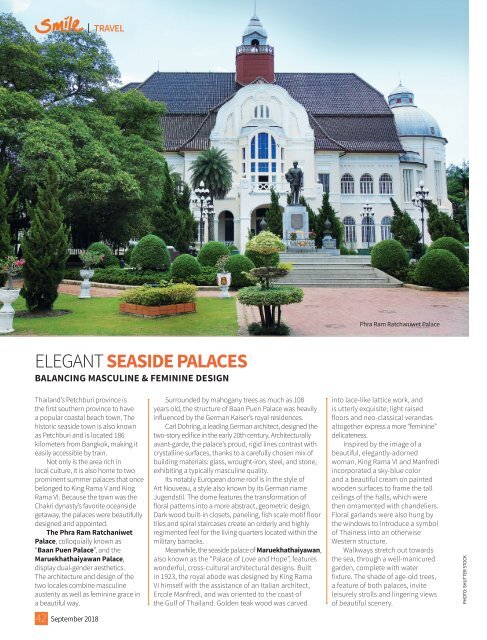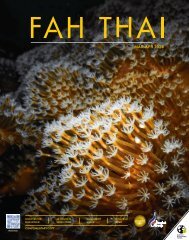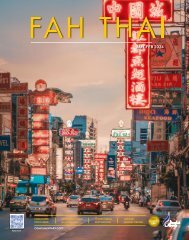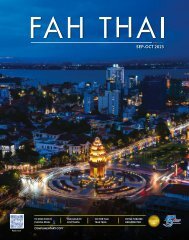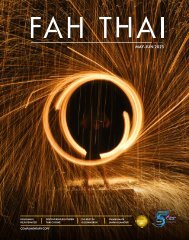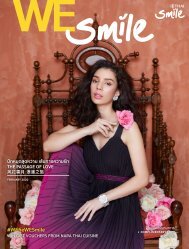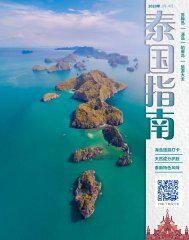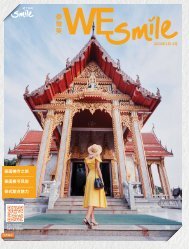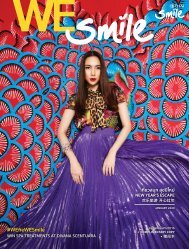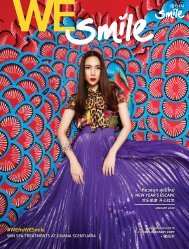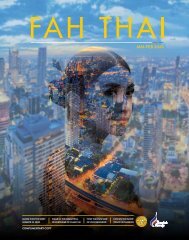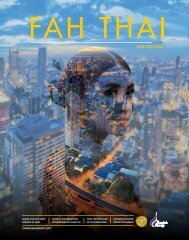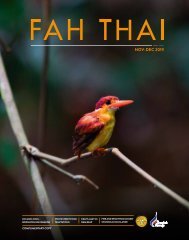You also want an ePaper? Increase the reach of your titles
YUMPU automatically turns print PDFs into web optimized ePapers that Google loves.
TRAVEL<br />
Phra Ram Ratchaniwet Palace<br />
ELEGANT SEASIDE PALACES<br />
BALANCING MASCULINE & FEMININE DESIGN<br />
Thailand’s Petchburi province is<br />
the first southern province to have<br />
a popular coastal beach town. The<br />
historic seaside town is also known<br />
as Petchburi and is located 186<br />
kilometers from Bangkok, making it<br />
easily accessible by train.<br />
Not only is the area rich in<br />
local culture, it is also home to two<br />
prominent summer palaces that once<br />
belonged to King Rama V and King<br />
Rama VI. Because the town was the<br />
Chakri dynasty’s favorite oceanside<br />
getaway, the palaces were beautifully<br />
designed and appointed.<br />
The Phra Ram Ratchaniwet<br />
Palace, colloquially known as<br />
“Baan Puen Palace”, and the<br />
Maruekhathaiyawan Palace,<br />
display dual-gender aesthetics.<br />
The architecture and design of the<br />
two locales combine masculine<br />
austerity as well as feminine grace in<br />
a beautiful way.<br />
Surrounded by mahogany trees as much as 108<br />
years old, the structure of Baan Puen Palace was heavily<br />
influenced by the German Kaiser’s royal residences.<br />
Carl Dohring, a leading German architect, designed the<br />
two-story edifice in the early 20th century. Architecturally<br />
avant-garde, the palace’s proud, rigid lines contrast with<br />
crystalline surfaces, thanks to a carefully chosen mix of<br />
building materials: glass, wrought-iron, steel, and stone,<br />
exhibiting a typically masculine quality.<br />
Its notably European dome roof is in the style of<br />
Art Nouveau, a style also known by its German name<br />
Jugendstil. The dome features the transformation of<br />
floral patterns into a more abstract, geometric design.<br />
Dark wood built-in closets, paneling, fish scale motif floor<br />
tiles and spiral staircases create an orderly and highly<br />
regimented feel for the living quarters located within the<br />
military barracks.<br />
Meanwhile, the seaside palace of Maruekhathaiyawan,<br />
also known as the “Palace of Love and Hope”, features<br />
wonderful, cross-cultural architectural designs. Built<br />
in 1923, the royal abode was designed by King Rama<br />
VI himself with the assistance of an Italian architect,<br />
Ercole Manfredi, and was oriented to the coast of<br />
the Gulf of Thailand. Golden teak wood was carved<br />
into lace-like lattice work, and<br />
is utterly exquisite; light raised<br />
floors and neo-classical verandas<br />
altogether express a more “feminine”<br />
delicateness.<br />
Inspired by the image of a<br />
beautiful, elegantly-adorned<br />
woman, King Rama VI and Manfredi<br />
incorporated a sky-blue color<br />
and a beautiful cream on painted<br />
wooden surfaces to frame the tall<br />
ceilings of the halls, which were<br />
then ornamented with chandeliers.<br />
Floral garlands were also hung by<br />
the windows to introduce a symbol<br />
of Thainess into an otherwise<br />
Western structure.<br />
Walkways stretch out towards<br />
the sea, through a well-manicured<br />
garden, complete with water<br />
fixture. The shade of age-old trees,<br />
a feature of both palaces, invite<br />
leisurely strolls and lingering views<br />
of beautiful scenery.<br />
PHOTO: SHUTTER STOCK<br />
<strong>42</strong><br />
<strong>September</strong> 2018


